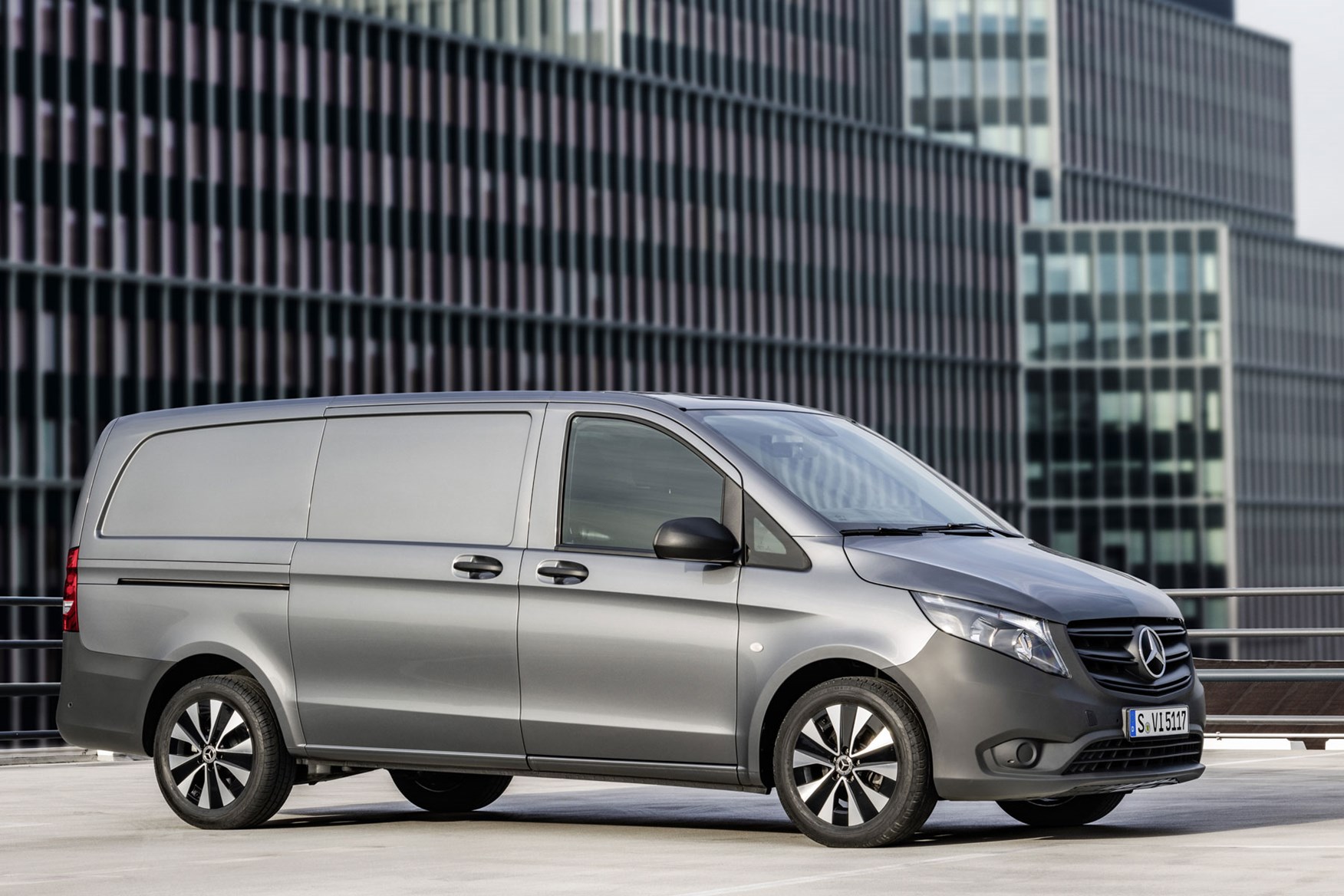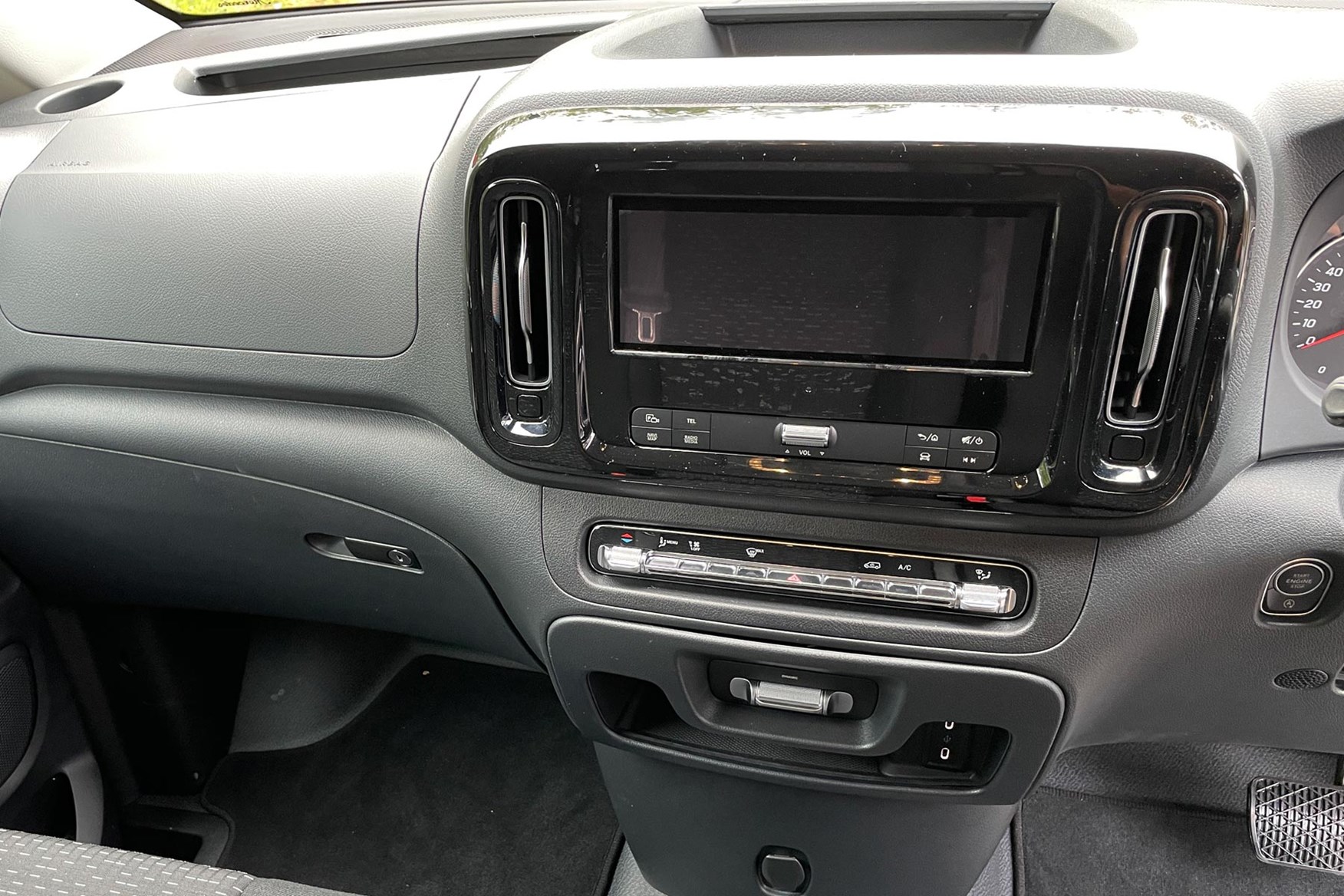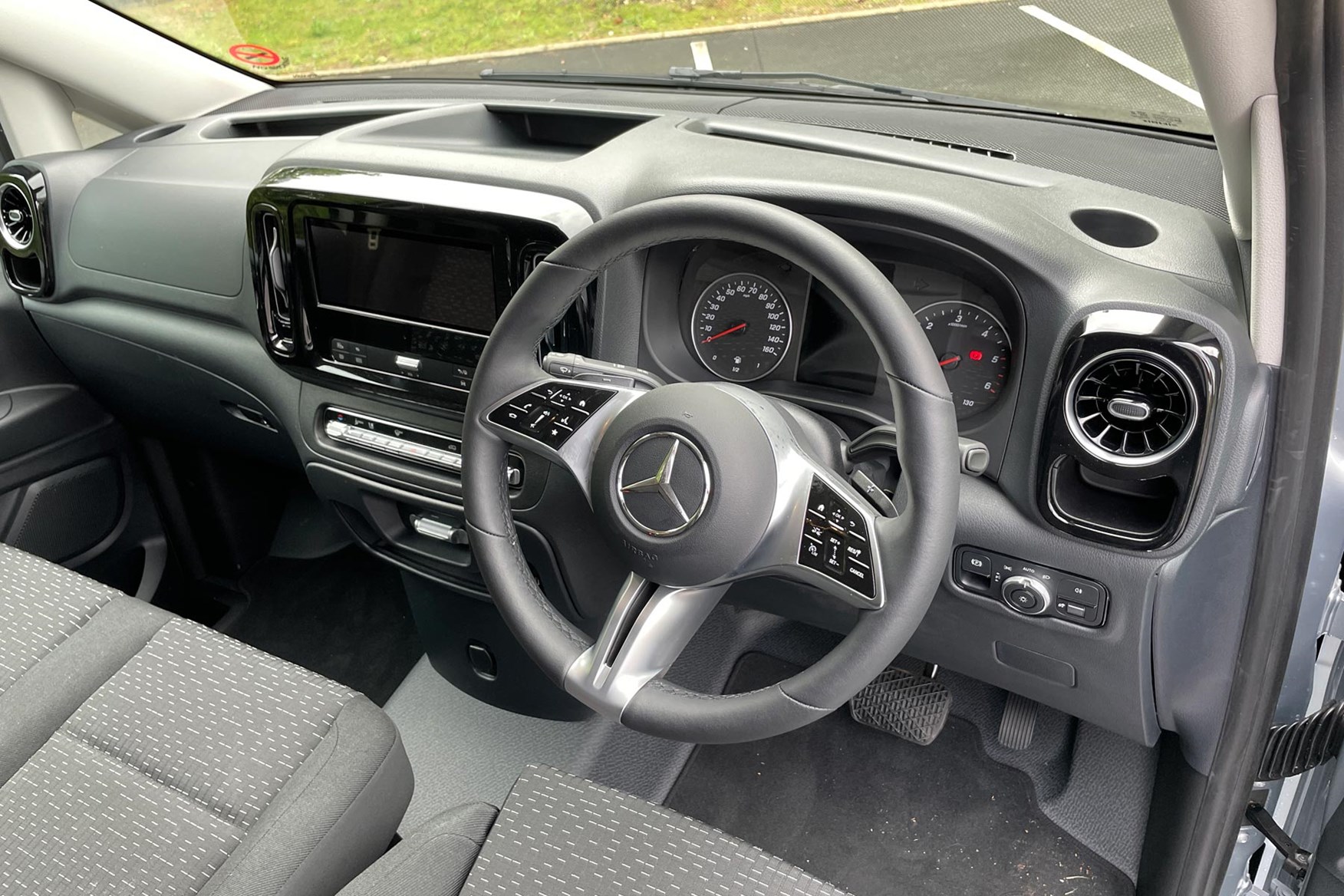Mercedes-Benz Vito van review (2024)
Does the Mercedes Vito still justify its posh image?
PROS
- More modern cabin
- High quality feel
- Long-distance comfort
- Good value
- High level of safety kit
CONS
- Stalk-mounted automatic gearstick
- Rivals offer higher payloads
- Cramped cab
- Some handy kit not standard
- No AWD, FWD or short model
Summary
The 2024 Mercedes Vito medium van gets an update that brings about some long-needed and welcome updates inside and out, with a modernised cabin one of the biggest upgrades. It's remains a relative rarity in the market, in that it is based on a platform that is unique to the brand - you won't find another manufacturer selling the same van with a different badge on the front.
Not all the 2024 updates are adding things to the Vito, though, as some elements have been removed too. There is less choice when it comes to the driven wheels and the sizes of body that are on offer, as Mercedes has chosen to consolidate and concentrate on the big sellers.
There is also a 100% electric version: read our separate Mercedes-Benz eVito review for full details.
What is new in the 2024 Mercedes-Benz facelift?
As has been the case with lots of updates in vans such as this, the big changes at the 2024 facelift are found in the cabin. This was a bit of a no-brainer in many ways, as this was where the Vito was lagging behind its rivals in recent times.
Now it has been seriously smartened up, with a standard-fit screen taking centre stage. It's a 10.25-inch unit and comes with the latest MBUX operating system. It will come with Apple Carplay and Android Auto, although a few early vehicles didn't.

There are also new touch-sensitive controls on the steering wheel and a second colour screen on the instrument display - a 5.5-inch one that contains more driving data.
Mercedes has tweaked the outside, too, but the emphasis is very much on the word tweak here. The grille and bumper have both been redesigned, while the lights have been updated too. As is often the case with a van, the basic trims get black plastic bumpers while the higher end models get body-coloured versions. There are new alloys and some additional colours to choose from as well.
What was new in the 2020 Mercedes Vito facelift?
The previous notable facelift was in 2020, and there wasn't much to say about the visual elements - it was limited to a new radiator grille and some detail changes inside the cab - but the 2020 Vito got a whole new set of engines, and a load of extra technology.

Rear-wheel drive models were powered by Mercedes' latest 2.0-litre turbodiesels, which started life in the passenger car range and are said to be super clean in terms of emissions.
Front-wheel drive Vitos, meanwhile, were powered by new 1.7-litre engines, which also brought efficiency gains.
Beyond this you'll find there was more safety tech available - including a clever digital rear-view mirror, autonomous emergency braking and Distronic active cruise control - as well as a new air suspension system and more modern nine-speed automatic transmission.
Mercedes Vito rivals
As you’d expect from the Mercedes badge on the front, it is one of the more premium choices on the market – which means you should expect to pay more for one of these than an equivalent Vauxhall Vivaro or Renault Trafic. The Ford Transit Custom might well have gone up in price a bit with the latest model but there are still plenty of well-equipped versions that clock in at less than the top-spec Vitos.
Historically the Vito’s closest competitor has been the Volkswagen Transporter, which also puts a premium on being more premium. However, the 2025 VW Transporter is going to take a somewhat different approach to the previous one, as it was co-developed with Ford. In essence this makes it an adapted Ford Transit Custom.
Mercedes Vito strengths and weaknesses
There’s no suggestion the Vito is actually bad value anyway. The saying ‘you get what you pay for’ applies to vans as much as anything else, and this Mercedes gives you a high quality of finish and a driving experience that does feel a cut above most competitors.
Historically, it has offered a choice of different driven wheels, but in 2024 you can only get a RWD version. This has come about as Mercedes looks to cut down the number of versions that it offers, in a bid to simplify the range. This is also the reason why there is no longer a short model - the only two you can get are the ones that were formally the medium and long versions. The latter isn't just a longer body, though, as it has a stretched wheelbase that brings greater stability but makes it a bit less agile around town with a related bigger turning circle.
Other positives include a solid reputation for reliability (the Vito consistently appears in the top 10 of the FN50 van reliability survey) that is backed up by and 30 years of roadside assistance cover (yes, 30, but only if you get your van serviced by Mercedes). It's got a great set of safety equipment, too, with the latest model earning a Platinum rating from Euro NCAP, putting it near the top of the list of the UK's safest vans.
Mercedes Vito bodystyles and variants
In addition to the regular panel van, Mercedes also builds the Vito as a crew van (meaning a second row of seats) and a Tourer (a lower cost alternative to the V-Class MPV in the Mercedes passenger car range).
But while the Vito was once offered in three body lengths there are now only the two, L2 and L3. If you are shopping for a used Vito then you might well see versions referred to as Compact, Long and Extra-Long - they were renamed L1, L2 and L3 in 2019. In any case, though there is only one roof height and has only ever been one.
There are only two trim levels, named Select and Pro, with quite a step up between the two in terms of price and therefore kit. One of the big differences between the two is the gearbox, as you can only get the Select with a six-speed manual while the Pro only comes with a nine-speed automatic 'box.
Previously there has been a seven-speed automatic, which was optional on the two less-powerful rear-wheel drive models, and fitted as standard on the range-topping version. Front-wheel drive models were restricted to a six-speed manual gearbox only, as also fitted as standard on the less-powerful rear-drivers.
Verdict: is the Mercedes-Benz Vito any good?
A relatively small and slightly cramped-feeling cab aside, the Vito cuts an impressive dash.
As a complete package it is starting to feel its age a little now, though. The updated cabin brings it up to a standard but there are others that provide more space and modernity. For some, though, the fact that there isn't a model that offers a payload over, or even very close to, the 1,000kg mark is a disappointment.
Skip to our full verdict on...
- Trimmed down engine range
- Now only available with rear-wheel drive
- Plenty of performance
The Vito was once available with front-, rear- and even four-wheel drive layouts, which was very unusual in the mid-size van sector, but as of 2024 things are slightly slimmer in the van's range. You can only get a RWD Vito now, while the engine range is not as extensive as it once was. There is now only a 2.0-litre diesel on offer, albeit with a choice of three different power outputs.
These are 136hp, 163hp and 190hp. We've only driven the most powerful version of the most recent facelifted Vito, which is badged the 119, and it is an excellent fit, if perhaps offering more power than most will need. Most will be more than fine with the 116 instead. Both are equipped, as standard, with a nine-speed automatic gearbox. This is the standard offering on both these engines, with only the 114 coming with the manual 'box these days.

The 9G-Tronic auto, as it is called, is a smooth and relaxing unit and is best left to just get on with its own thing, although, somewhat unusually for a van, you can change gear manually using a pair of paddles situated behind the steering wheel.
Excellent handling with long-distance comfort
The majority of the Vito's driving characteristics have remained unchanged over the years, including the ride and handling elements. Some have complained that the electrically assisted power steering is a little too light around town. But we find its accuracy more than makes up for this, and the Vito generally very pleasant to drive.

Although visibility isn't brilliant due to the narrow windows, the suspension is finely balanced between delivering good long-distance ride comfort and suppressing bodyroll in the corners - meaning you can make quick progress on all types of roads.
There's no longer the ability to choose between front-, rear- or all-wheel drive, with only a RWD version on offer as of 2024. This is largely beneficial, as the RWD model handles nicely and doesn't suffer anything extra in terms of cabin noise, as sometimes happens on vehicles where there are more mechanical parts needed to send the power from the engine to the wheels.
- Interior gets sorely needed update
- No basic trim with utilitarian dash
- Some oddly placed controls
Finally the Vito has a cabin that feels more befitting of the Mercedes brand, having long felt like it was very outdated and from a long-gone generation.
The 2024 update has brought about a colour touchscreen in the middle of the dash that plays host to all the sort of features that you would expect of a modern van including Apple Carplay and Android Auto. Even something as simple as DAB digital radio hasn't been standard fit up until relatively recently on the Vito, so this all represents a welcome update.
However, the problem is that there are rivals in the Vito's class, like the Ford Transit Custom for example, that have moved the game on.

The quality of fit and finish is high, and we like the seats and the driving position. If you're coming to a Vito from another brand of van, there will be a few things you will need to get used to.
Unusual interior controls and features
Slightly oddly, the features that were unusual before are no longer, but there are some other elements that might feel strange to those who have come to the Vito from another brand.
The good news is that Mercedes' foot-operated parking brake is no longer, due to the advent of an electronic version. This is still a bit strange, being tucked down to the right of the steering wheel and it will likely take a few times before you work out if you need to pull or push it to put the brake on. However, it's less of an outlier now that plenty of other vans are switching to electronic button-operated parking brakes.
The gearstick for the automatic transmission, which is located behind the steering wheel on a stalk where you would usually find the controls for the windscreen wipers, is also less unusual now that Ford has moved to a similar setup on its Transit Custom. It would be nice if it was shaped a bit less like a conventional indicator stalk, though, to remove a touch of early-adoption confusion.

Obviously, you'll get used to these things in time, but if you're regularly hoping between vehicles it will continue to be rather jarring.
What is particularly annoying, though, even with the benefit of time and practice, is the touch-sensitive controls for the cruise control and volume on the steering wheel. You have to slide your thumb up and down to increase speed or volume, which runs counter to every intuition. Not only does it require an irritating level of accuracy, it is also impossible to control with gloves on. It's innovation for innovation's sake and adds nothing of benefit.
Not as spacious as some rivals
Compared to likes of the Transit Custom and Transporter, the Vito's cab is rather cramped, with a relatively narrow windscreen and low ceiling. There is a good amount of storage on offer, though, with three slots on the top of the dash a welcome feature, even if they are uncovered.
The middle seat isn't huge - this isn't unusual for a medium-sized van - but the automatic models do better due to the lack of gear lever intruding into the space needed for knees. The dash lower down does eat into the foot space, though.
Overall, the cabin has taken a welcome step forward, but it still doesn't hide the Vito's advancing years. It's got the kit, but not the necessarily all the panache needed to justify the premium image.
- Expensive to buy but holds its value well
- All models are now well equipped
- Average fuel economy, 25k service intervals
While the Vito certainly isn't the cheapest medium van on the market, strong second-hand values help keep monthly finance payments competitive, and running costs shouldn't be too unreasonable.
Mercedes-Benz Vito mpg
Maximum claimed fuel economy for a Vito is middle of the road, with no version in the range offering anything better than 39mpg. On the flip side, none of them offer anything less than 37mpg, so there are no models to specifically avoid on fuel economy grounds.
Mercedes Vito service intervals
The Vito requires a service once every 25,000 miles or two years, whichever is sooner.

Traditionally, official Mercedes servicing has always been thought of as quite expensive, but the company has been working hard to reduce costs, with the availability of Mercedes' own line of re-conditioned parts bringing further savings.
It's also worth noting that if you do get your Vito serviced by Mercedes-Benz, you automatically get roadside assistance cover. This can be reactivated with a service at Mercedes right up until the van is 30 years old.
>> For an insurance quote on the Mercedes Vito try mustard.co.uk
Mercedes-Benz Vito equipment for 2024
There are just the two trim levels as of 2024, and the names have evolved from previous versions. At this point they are called Pro and Select, and the highlights of the two are below. Pro is only available with the 114 engine and the manual gearbox, while the two more powerful engines are only offered with the Select trim
Mercedes-Benz Vito Pro equipment highlights:
- Air conditioning
- Three-seat cabin
- Multifunction steering wheel
- Lockable glovebox
- 17-inch steel wheels
- 10.25-inch colour touchscreen
- Apple Carplay and Android Auto
- Wooden loadbay covering
- Twin side loading doors
- Cruise control

Mercedes-Benz Vito Select equipment highlights (in addition to Pro):
- Leather steering wheel
- Chrome interior details
- Grab handles for driver and passenger
- Extra interior lighting in cabin and loading bay
- 17-inch alloy wheels
- Headlight assist
- Colour-coded front and rear bumpers
Mercedes Vito trim levels for 2019
In January 2019 Mercedes announced three new trim levels for the Vito: Pure, Progressive and Premium. Then in September 2019, Mercedes also brought back the Vito Sport - although this is only available as a Crew Van or Tourer. However, in 2022 the Pure trim was dropped, leaving just Progressive and Premium.
Mercedes Vito Progressive standard equipment highlights:
- Metallic paint
- Colour-coded bumpers
- Audio 30 infotainment system with colour screen, Apple Carplay, Android Auto, DAB digital radio
- Electric-folding door mirrors
- Front fog lights
- Cruise control with speed limiter
- 'Comfort' driver's seat with lumbar support
- Double passenger seat
- Leather multifunction steering wheel
- Reversing camera
- Heat-insulating glass
- Automatic headlights
The Vito Progressive is available with all engine options except the most powerful 119 CDI.
Mercedes Vito Premium standard equipment highlights (in addition to Progressive):
- Air-conditioning
- 17-inch alloy wheels
- Chrome radiator grille
- Powered door mirrors
- Anti-theft protection package with double lock
- Velour floor mats
The Vito Premium came as a 116 CDI or 119 CDI.
The Vito always performs well in the FN50 van reliability survey - though not as well as its Sprinter big brother, which consistently finishes as the number one most reliable van in the UK.
- Vastly improved levels of safety kit
- Earned a Platinum rating from Euro NCAP
- Most equipment offered as standard
The 2024 update has brought about a huge improvement as far as the Vito's safety is concerned, with a greater degree of driver assistance kit. This has resulted in the van earning the highest level of rating from Euro NCAP - it is now the proud holder of a Platinum score. In fact, at the time of writing, there are only a few vans that have done better than the Vito's 90% rating.
Mercedes Vito safety
Thankfully the majority of the safety-related equipment comes as standard. This comes in the form of preventative driver aids and reactive protective features. Below are the highlights
- Driver and passenger airbags
- Adaptive ESP (electronic stability control) - varies the braking force required to prevent a loss of grip depending on the weight and position of the van’s load
- Attention Assist - detects driver fatigue
- Hill-Start Assist
- Active brake assist
- Blind spot assist
- Reversing camera
- Cruise control
If you upgrade to the Select model then you also get a parking assistant with a reversing camera.
Mercedes Vito security
The Vito's security levels have been boosted with the 2024 update, too, with the anti-theft package now offered as standard. This brings a Thatcham-approved alarm, cab interior and load-space monitoring and tow-away protection.
Which Mercedes-Benz Vito is best for me?
Your choice in the Vito range is now far narrower than it once was. We used to rave about how you could get a choice between rear-, front- and all-wheel drive Vitos, but this has been pared back to just RWD as things stand in 2024.
There is less choice when it comes to the spec, too, with only Pro and Select models now. Given the uptick in features in the lower Pro model, you would do as well to go for that, however you can only get this trim with the lowest power engine.
We'd go for the mid-range diesel or above, not least to get the nine-speed automatic gearbox that makes for a more relaxing drive. It also frees up a bit more space in the cabin so it is a more practical option too.
FWD should be the more economical set-up, and these models are typically cheaper to buy. But the difference in mpg and list price isn't that great, and we've always found the RWD Vito a far superior product. RWD also offers greater loaded traction.
The middle power output is typically the most popular in either variant, but up until 2019 trim levels were less formalised (with the exception of Sport models) - so if buying used you'll have to check the exact specification of the van you're considering very carefully to make sure it's got the kit you require from the options list.










